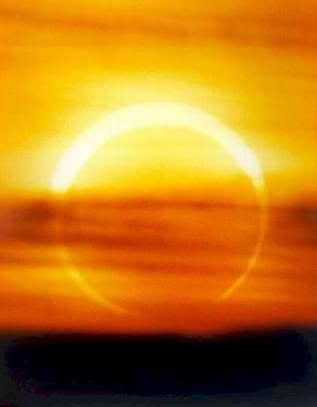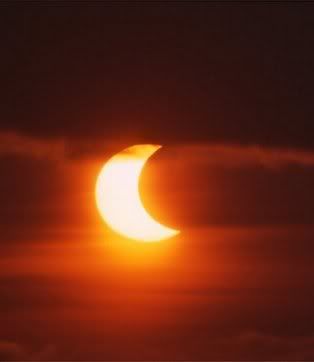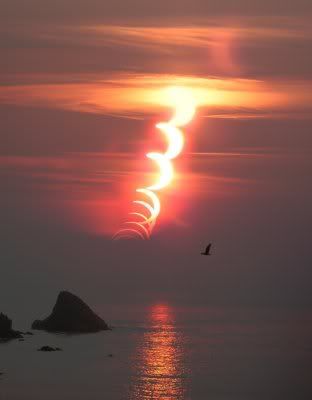
Incandescent Cradle Of Light
Awwwwww, I wish I could have caught the splendid sight of yesterday morning's spectacular anuular eclipse from the Iberian Peninsula through the heart of Africa. In this rare kind of eclipse, the moon crosses in front of the sun during the farthest point in its orbit, making the moon appear too small to fully cover the sun, and, abracadabra, the result is a blazing ring in the sky as many lucky trans-Atlantic Jacque, Jose and Jawara Stargazers got to catch! :)
This is the first annular eclipse the Iberian peninsula has gotten to see in 241 years, with the next showing coming in 2028. :) It started at 4:41 in the morning, where first it passed through northern Portugal, onto Madrid, and after travelling through Portugal and Spain for three-and-a-half hours, soared through the deserts of northern Africa, through Somalia, and finally setting over the Indian Ocean.

During an annular eclipse, the moon travels between the Earth and the sun, leaving behind a bright, fiery rim, and the moon is too small to blot out the sun completely, because its elliptical orbit has taken it too far from the Earth, which always leaves us this scintillating rim in the sky. :)
:) For those American and Canadian stargazer friends of mine who are dying to know when the next chance is to catch this resplendent rara avis, if you live on the western side of the U.S with me, be prepared to be dazzled May 20th, 2012, when an annular eclipse is scheduled to rise in China, hover through Japan, and cross the Pacific Ocean and kissing the Pacific end of the United States before flickering away. Those of you further to the east of the continent may have to wait until January 26, 2028 to witness an annular eclipse rising in the eastern U.S, making its way through Central and South America as well! :)

There are so many fascinating myths and beliefs among many cultures worldwide about eclipses. Burundians believe that an eclipse marks a time when the Earth and heaven are linked and is considered an omen for great misfortune, including poor harvests, the death of precious cattle, an epidemic or conflict. This would be one I hope is not true and rather a sign for great hope and love to bless their culture! :)
Here in the northwest, the Pomo tribe name for a solar eclipse was "sun got bit bear." They believe that one day, a bear went out for a stroll along the Milky Way, where soon it met up with the Sun and the two began to argue about who would move out of the other's path. The argument heated up, which was represented by an eclipse of the Sun. And so, eventually, the Bear continued along his way, but soon met up with the Moon, the Sun's sister. Once again, the Bear got into an argument about who would move over and again the argument turned into a fight. Now there was an eclipse of the Moon. After the eclipse Bear continued on his way along the Milky Way and the cycle continues to go on! :) That silly stubborn bear! ;)
In Navajo tradition, there is also a beautiful story which is now a beautiful children's book recounted by Navajo author Baje Whitethorne titled "Sunpainters: Eclipse of the Navajo Sun", which is about a little boy and his grandfather, who the grandfather tells the boy to look outside but not to look at the sun, and asked if he could see all the deep shades of purple and reds all around the mountainside, explaining that it is all the art of the Na'ach'aabii, the Little People who are summoned from the four directions of the Earth to repaint the sun when it dies and the universe with all the colors of the earth and the rainbow. :)

:) I've got my celestial sleeping bag all unfolded already for 2012! Of course, you can catch the most exciting type of eclipse, a total eclipse, on August 21, 2017! :) Especially for y'all on the east side of the country, there's a treat for you before the next annular eclipse! :)
:) Keep lookin' up, star-studded sneeches!
Love,
Noah Eaton
(Mistletoe Angel)
(Emmanuel Endorphin)










































0 Comments:
Post a Comment
<< Home